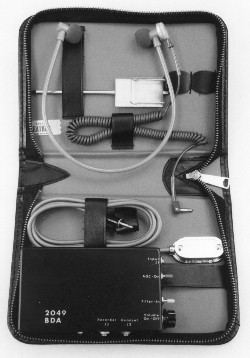2049M
ELECTRONIC STETHOSCOPE
 The 2049M Stethoscope consists of the 2049BDA amplifier, contact
microphone/probe, special 2,000 ohm headset with ear hook and a
carrying case. The system is designed primarily to detect
conducted (seismic) sounds generated by mechanical clocks and
trigger devices. The 2049BDA contains a low noise amplifier with
switchable automatic gain control (AGC) and high/low pass filter.
INPUT J1, accepts transducers (i.e. contact microphones) with
impedances ranging from 10K to 500K ohms. The HEADSET J2 jack
accepts headsets with a nominal impedance of 2,000 ohms (supplied
with system) but will also accept headsets with impedances ranging
from 600 to 50,000 ohms. The RECORDER J3 jack is designed to match
the high impedance input of a tape recorder. This jack is normally
connected to the AUXILIARY or AUX input of the recorder. If the
recorder does not have an AUX jack, a 100/1 attenuator cable is
required to prevent overloading.
The 2049M Stethoscope consists of the 2049BDA amplifier, contact
microphone/probe, special 2,000 ohm headset with ear hook and a
carrying case. The system is designed primarily to detect
conducted (seismic) sounds generated by mechanical clocks and
trigger devices. The 2049BDA contains a low noise amplifier with
switchable automatic gain control (AGC) and high/low pass filter.
INPUT J1, accepts transducers (i.e. contact microphones) with
impedances ranging from 10K to 500K ohms. The HEADSET J2 jack
accepts headsets with a nominal impedance of 2,000 ohms (supplied
with system) but will also accept headsets with impedances ranging
from 600 to 50,000 ohms. The RECORDER J3 jack is designed to match
the high impedance input of a tape recorder. This jack is normally
connected to the AUXILIARY or AUX input of the recorder. If the
recorder does not have an AUX jack, a 100/1 attenuator cable is
required to prevent overloading.
OPERATION: Insert the contact microphone/probe into J1 and the headset supplied into J2. The headset is worn with the gray stethoscope tube UNDER the chin with the sound output holes facing
slightly forward (30 degrees). Place the AGC-ON switch in the down
or off position. Hold or place the contact microphone against the
object under test (direct contact is mandatory). Rotate the VOLUME
control slowly clockwise until the desired headset level is
obtained. Select the FILTER switch position that gives optimum
performance. If the probe is moved frequently or the surface is
excessively noisy, turn on the AGC by placing that switch in the on
or up position. Turn the VOLUME control to approximately 4
O'Clock. Once the AGC level has been set, it is no longer
necessary to adjust the VOLUME control. Note that the volume
automatically drops when the probe is moved and then returns to
normal in 3 to 4 seconds.
The 2049BDA contains a single 9 volt battery which provides
approximately 50 hours of "ON" time. Alkaline batteries are always
preferred. As with any piece of sophisticated electronic
equipment, remove the battery during periods of prolonged storage.
When in the AGC mode, the headset level is controlled by the small
potentiometer (variable resistor) located on the back portion of
the circuit board. Use a small screwdriver to set this control to
a higher or lower headset level.
Although designed primarily for bomb detection the 2049M has many, many applications. Some applications may be controlled by 18USC2512 or other federal, state or
local laws. It is the owners responsibility to check for lawful use.
EC50 50 foot probe extension cable (use up to two)
EC100 100 foot probe extension cable
NOTE: Do NOT use more than 100 feet total
of extension cable.
DM80 Waterproof dynamic contact microphone.
SM80-12 12 inch spike (allows insertion of probe into soil)
AC80-100 100 to 1 attenuator cable
HS80-EM Padded noise-canceling headset
2010A Doppler stethoscope with audio amplifier.
2047U/C Combination contact and ultrasonic stethoscope.
4020 Mini stethoscope.
4040DLT Wire communicators.
4059C Non-Linear Junction Detector.
8010G Beat Frequency Metal/Mineral Detector.
IRD59-2 Infrared trip beam detector.
POW-GAL27 Low voltage blasting machine and galvanometer.
POW-GAL100 High voltage blasting machine and galvanometer.
CAP-SHOK-2K High voltage blasting machine and galvanometer
AND Shock tube initiator.
|
8/16